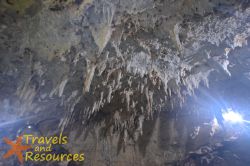 I love the beauty of Mother Nature. Being able to see the many beaches, mountains, waterfalls, and just caves never gets old. And two of the places that are rich in these four things are Palawan and Bohol. And one of the interesting caves to see is for the latter is Hinagdanan Cave.
I love the beauty of Mother Nature. Being able to see the many beaches, mountains, waterfalls, and just caves never gets old. And two of the places that are rich in these four things are Palawan and Bohol. And one of the interesting caves to see is for the latter is Hinagdanan Cave.
Table of Contents
Brief Background
The cave gets its name from hagdan, which means steps. The word is typically used for stairs, or in this case, for a ladder which was utilized to enter and exit the cave when it was discovered years ago.

Ceiling
The cave was discovered way back in the 16th century as the owner of the land then was clearing it out so it could be tilled. And the heavy vegetation was slowly removed they discovered a hole in the ground.
When a stone was thrown in to get an idea of its depth, the sound that returned was a splash instead of a dull thud. A ladder was then lowered down the hole and a pool of water leading to the sea was discovered. And thanks to this ladder, Hinagdanan Cave got its name.
Exterior
Instead of just two holes in the ground, Hinagdanan Cave now has a receiving area, compete with fixed benches. This is where visitors pay an entrance fee of PhP 25 per person.

Entrance
Fortunately for the average tourist, one does not have to descend via a flimsy bamboo ladder anymore. The owners over the land have built stairs made of cement and attached handrails made of metal. So senior citizens and children can go down without too much difficulty.
[Watch you head, though.]

Hole behind a Gate
A few steps behind the entrance are the two original holes found back in the 16th century. To prevent people from accidentally falling in, as well as to prevent erosion, a steel fence has been built around the holes.
Birds fly out in the mornings and back in during the afternoons. On the other hand, bats fly out during the afternoons and back in close to dawn. Interestingly, there are still birds that dart in and out during the day so the interior of the cave is full of muffled tweeting and fluttering sounds.
Interior
Bohol is made up primarily of limestone so when it comes to it 1,400 plus caves, they can be quite a sight to behold.
Just like many caves, there is an abundance of stactites hanging from the ceiling and stalagmites seemingly growing up from the ground.

Ceiling
What makes Hinagdanan Cave unique is that there is a pool of water covering much of the floor. It is connected to the sea so it becomes salty during high tide and less salty during low tide. Created over the centuries by the constant dropping of water, they now act as homes to many bats and birds.
The locals enjoy bathing in the water as it is cool and free of toxic pollutants. Tourists, not so much, because they don’t relish the idea of getting in to water with bird and bat droppings. The droppings are the things you see floating on the surface of the water.
[Don’t worry though, it’s quite safe to touch the water.]
Another telltale sign that the water is free of toxins is the presence of fish in the pool of water. If you allow your eyes enough time to adjust to the darkness, you’ll find the bigger one in the center, with the smaller ones nipping moss by the edge of the pool.

Pool
Getting back to the droppings, it would be a good idea to close your mouth whenever you gaze up at the ceiling. Our guide jokingly pointed out that if the drop you feel on your forehead or nape is cold, it is water coming from one of the stalactites above you. But if it is warm, well, you’ve just been blessed with bird or bat droppings.
[Consider yourself blessed it didn’t land in your mouth!]
Another thing that makes this cave stand out from the rest is the team of guides. Apart from being very entertaining, they know their history quite well. In addition to this, they have been trained in the use of cameras. So tourists don’t be worried about handing your expensive dSLR to them because these guides may actually know more about cameras than tourists do.
In my case, I was pleasantly surprised that our guide knew how to adjust the ISO, aperture, and flash of my Nikon D5100.
Souvenir Shops

Souvenir Shop
When it comes to the variety of clothes, you’ll find more in Aproniana Souvenir Shop. Their prices are a little higher because the quality and material used for their shirts are thicker in order to last longer.
In the case of the souvenir shops near the cave, prices are much cheaper because you can haggle with the salesladies for lower prices. You’ll need cash for purchases here as they do not take credit cards, though.
So if you happen to be visiting Hinagdanan Cave, take a look at their clothes.
Suggested Camera
A typical compact digital camera and mobile phone camera can take pictures in the cave, but you’ll most likely need to activate the flash.
In the case of a dSLR, the built in flash should be enough for group pictures. But if you might not be able to take pictures of the ceiling and walls that are further away, you’re better off adding an external flash to your camera.
When it comes to lenses, the 35mm F1.8 is an excellent choice. I would also suggest adding a wide angle lens to that so you can get more of the cave’s interior in your shots.
I understand that tripods or monopods are not allowed. Since several tour groups can be inside the cave at once, tripods or monopods can pose a danger.
Final Thoughts
Well, that’s all for me today. I’ll be covering other the places we visited in Bohol in coming articles. These include Blood Compact Site, the Loboc River Cruise, the Bilar Man-Made Forest, the Butterfly Conservation Center, the Tarsier Conservation Area, and the Aproniana Gift Shop. I hope you can join me in the near future as we go through this wonderful place known as Bohol.
Before I go, you might want to keep an eye out for an insect or two lying around because Bohol is very rich in natural resources. While I was waiting for my family to finish buying souvenirs, I stumbled upon a juvenile Praying Mantis on a water bottle. I ran to our van to get my Macro lens and when I returned, it gamely posed for me as I took picture after picture of it.
Must Do’s
- Wear shoes with good grip as it can be slippery.
- Bring a face towel as it is humid.
- Travel light as it is a small cave.
- Use a dSLR lens with a large aperture.
- Take your wide dSLR lens in with you.
- Attach an external flash if you have one.
Must Don’ts
- Do not eat inside the cave.
- Do not touch any of the walls.


Comments are closed